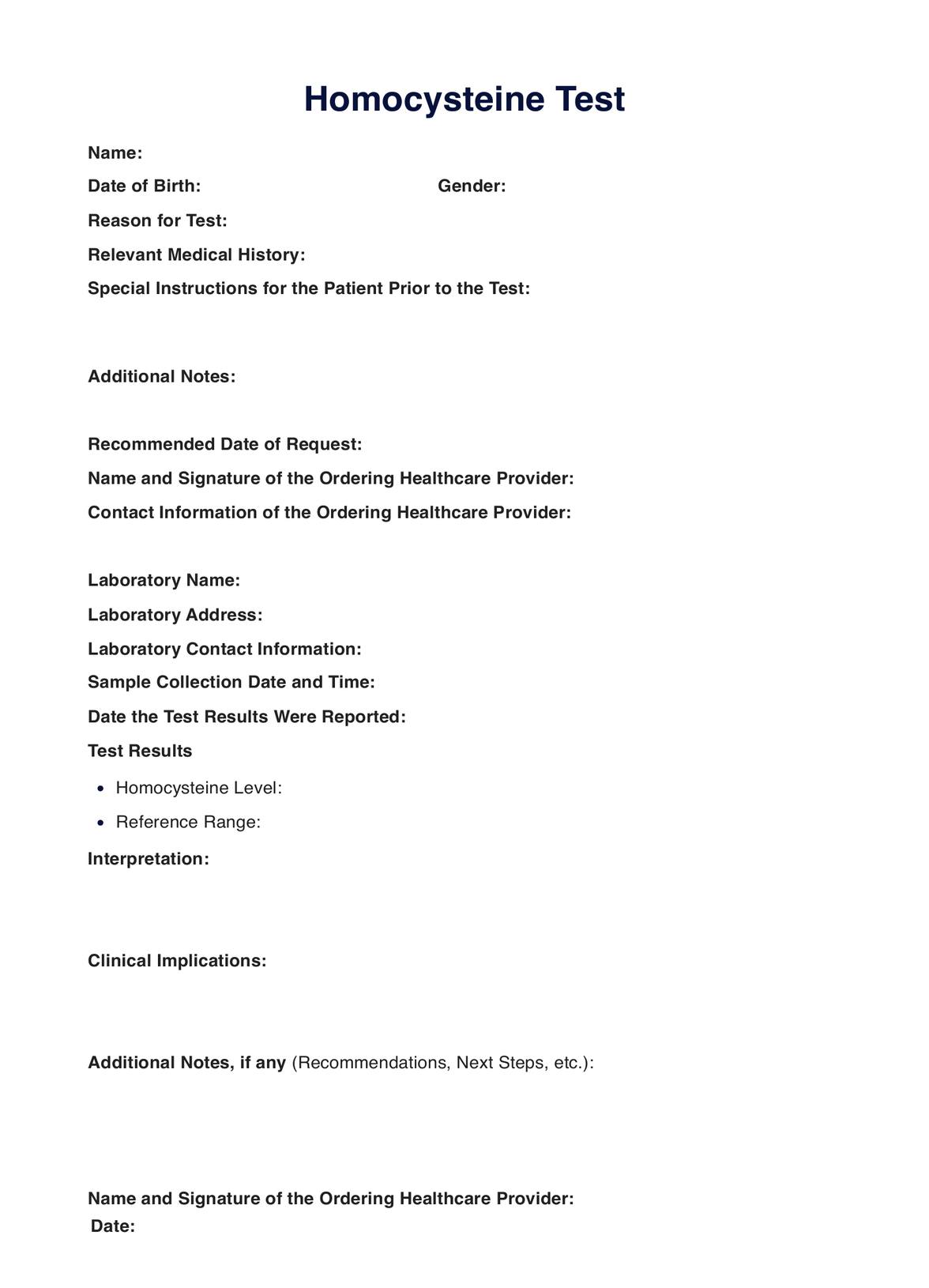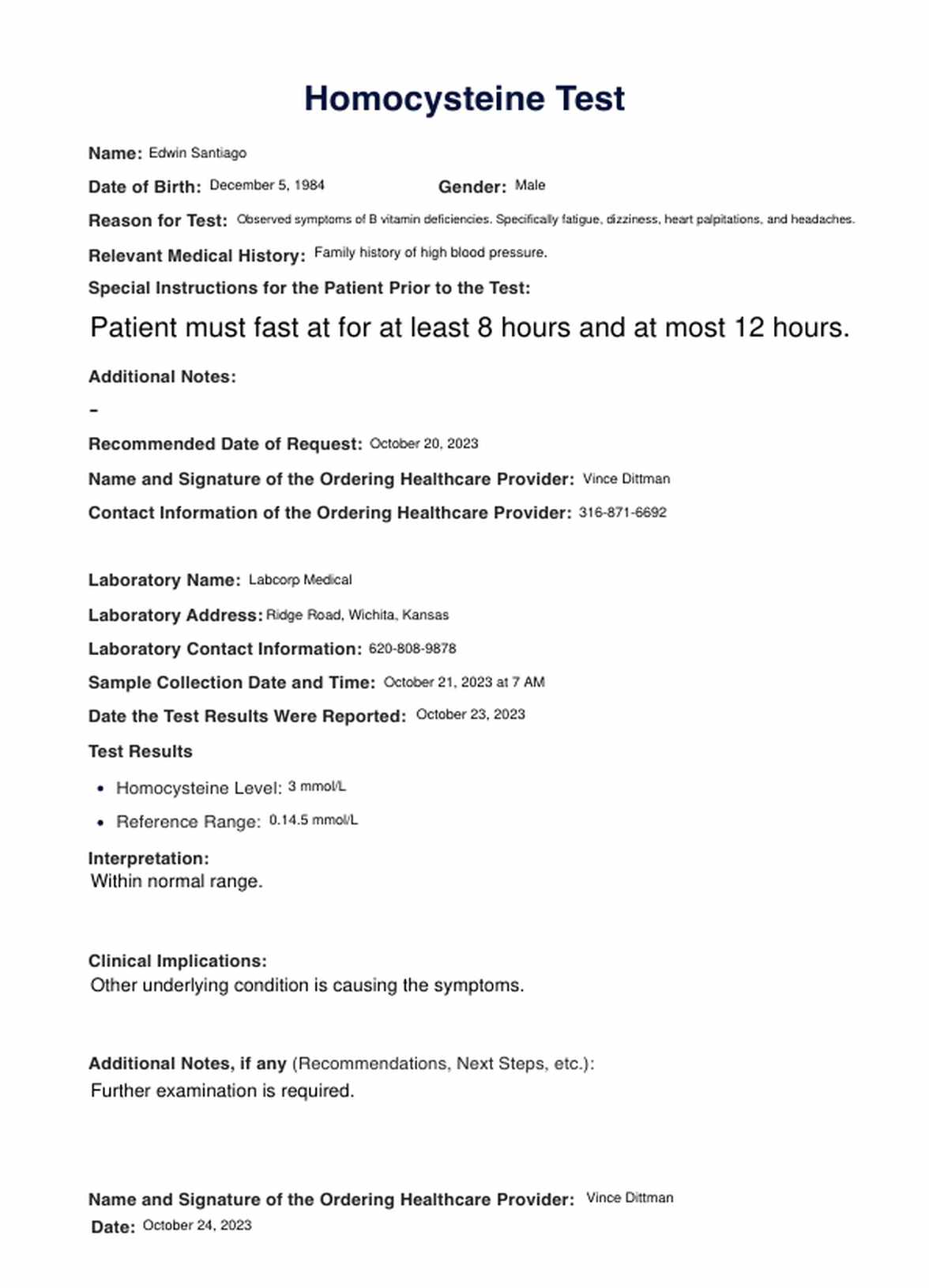Homocysteine Test
Learn more about the Homocysteine Test, its uses, result interpretation, etc. Click our short guide for more information and a free request form template.


What is a Homocysteine Test?
A homocysteine test is a diagnostic blood test that measures the concentration of the amino acid homocysteine in the bloodstream. Practitioners usually use the test to identify deficiencies of B vitamins, specifically B6, B9, or B12.
The vitamins’ role is metabolizing homocysteine so that they may become vital substances required and used by the body. Should there be an inadequate amount of B vitamins to break down the homocysteine, the patient may have elevated homocysteine, which can increase the risk of cardiovascular diseases. The test is also used to help diagnose a rare condition in newborns called homocystinuria. This disorder prevents the body’s ability to process specific amino acids.
The test’s procedure is simple and similar to other medical tests wherein a blood sample is collected from the patient to be processed in a laboratory and interpreted by the referring physician. Before the test, however, the patient may be required to fast for eight to twelve hours and inform the referring physician regarding any medication or supplements that may affect their test results.
One important thing to note with this test is that it must not used solely as the basis for a diagnosis.
Homocysteine Test Template
Homocysteine Test Example
How does it work?
Step One. Access and Download the Template
Secure a copy of a digital and printable PDF file of the “Homocysteine Test” to bring out when needed by accessing and downloading the template, following either of the steps mentioned below:
- Click the “Use Template” or “Download Template” button
- Search “Homocysteine Test” in Carepatron’s template library’s search bar on the website or app.
Step Two. Interview, Assess, and Examine the Patient
Before requesting a Homocysteine test, it’s best to interview and assess your patient’s risk of developing a heart disease/stroke or perform a physical examination to determine if the test is the appropriate assessment, alongside others, for their medical history or symptoms. If it is, fill out the request form section of the template.
Step Three. Collect a Sample
Before collecting a sample, have your patient fast and bring a filled-out request form to the laboratory to prove that you requested the homocysteine test. Only then will the practitioner in charge collect a sample for analysis and interpretation.
Step Four. Analyze and Interpret the Results
When you and your patient have the results, you may proceed with analysis and interpretation. You can use the document section of the template for any findings or observations you may use as a guide or reference for further examination for diagnosis and treatment approach formulation.
Step Five. Store the Template Securely
Once completed, store the template securely. For physical copies, it’s recommended that you store them within the establishment for quick and easy retrieval. Digital copies are encouraged to be stored on Carepatron, a HIPAA-compliant, free patient records software, along with other patient records where you can limit viewing access to relevant parties only.
When would you use this test?
General physicians and nurses can request a homocysteine test in the following situations:
Identifying the Cause of Symptoms and Diagnosing
If the referring physician suspects that the patient has vitamin deficiencies, specifically vitamin B6, B12, or B9, they may request the patient to undergo a homocysteine test. Signs or symptoms of having a deficiency of mentioned B vitamins are fatigue, dizziness, heart palpitations, headaches, mouth sores, skin/nail color changes, and tingling/numbness in the extremities.
Although the homocysteine test isn’t meant to be the sole basis for diagnosis for adults, it can be used to diagnose homocystinuria in newborns. This rare genetic condition impairs one’s ability to process particular amino acids. Early detection and diagnosis are essential for immediate management and intervention.
Monitoring Risk Assessment and Condition
A healthcare practitioner may request a homocysteine test to assess a patient’s risk of heart disease, stroke, or other problems related to the blood vessels, especially if they have a history of the disease or have high blood pressure. Aside from that, if the patient is already diagnosed with a heart disease, the practitioner can use the homocysteine test to monitor the progression of their condition. Having the results from this test can help the practitioner make informed decisions regarding the next steps.
It’s important to note that there are still studies concerning the associated contribution of elevated homocysteine levels to heart and blood vessel diseases. Therefore, healthcare practitioners are encouraged to make decisions based on their expertise, the patient’s risk factors, and clinical indicators rather than ordering routine testing.

What do the Results Mean?
Like all medical tests, analysis, and interpretation must consider the context of the patient. However, if you need a guideline that outlines the typical meaning of different homocysteine levels you may encounter and write down on your free Homocysteine Test, keep reading below:
- Normal Range: If the patient’s homocysteine levels fall between the general optimal range, which is between 0 to 14.5 µmol/L, then it means that they are most likely in good health.
- Below the lower limit: If the patient’s homocysteine levels are below the lower limit, generally, it’s associated with good health. However, it’s important to consider whether vitamin supplementation affects the levels.
- Higher than the upper limit: If the patient’s homocysteine levels are beyond the upper limit, it may suggest deficiencies in vitamin B12 and folate or malnutrition. This means they are at greater risk of stroke or heart attack.
- Very high levels: Any result that exceeds 100 µM means that the patient has severe hyperhomocysteinemia and must be given medical attention immediately.
If newborns have significantly increased concentrations of homocysteine in their blood and urine, it means that they have homocystinuria. Further testing may be required for early diagnosis, management, and intervention.
Research & Evidence
There have been studies research that explore the utility of homocysteine testing. Currently, researchers have gained valuable insights into its potential role with regard to assessing cardiovascular diseases, vitamin deficiencies, and even cancer markers. Here are the studies to prove it:
Cardiovascular Diseases
Mendelian Randomization studies explored the potential causal relationship between homocysteine and B vitamins and their impact on cardiovascular diseases. What they’ve discovered is that there is a suggested association between the increased risk of such diseases and higher genetically predicted homocysteine levels. Direct causality, however, still remains uncertain, and they can only suggest, based on their findings, that homocysteine is one of the many contributing factors to cardiovascular health.
Vitamin Deficiency
It has been proven that the homocysteine test is a valuable tool for diagnosing deficiencies in vitamins B6, B9, and B12. Its usage within the medical community is enough to prove its utility, specifically in guiding healthcare practitioners when recommending which supplement the patient must take for overall good health.
Cancer Marker
There is research that explores the potential of homocysteine as a lung cancer marker since they’ve noticed that patients with lung cancer have alternations in total homocysteine, folate, and glutathione levels in their body compared to one without cancer. However, further research still has to be done to prove its applicability and utility in diagnosing and managing said cancer.
To summarize, homocysteine proves to be a valuable tool in diagnosing vitamin deficiencies and has potential roles with regard to assessing cardiovascular health and cancer progression. To make the most out of the homocysteine test, the healthcare practitioner is encouraged to assess and use it on a case-to-case basis, considering the patient’s medical history, condition, etc.
References
Özkan, Y. (2007, March 1). Usefulness of homocysteine as a cancer marker: total thiol compounds and folate levels in untreated lung cancer patients. Anticancer Research. https://ar.iiarjournals.org/content/27/2/1185
Professional, C. C. M. (n.d.). Homocysteine test. Cleveland Clinic. https://my.clevelandclinic.org/health/diagnostics/22393-homocysteine-test
Yuan, S., Mason, A. M., Carter, P., Burgess, S., & Larsson, S. C. (2021). Homocysteine, B vitamins, and cardiovascular disease: a Mendelian randomization study. BMC Medicine, 19(1). https://doi.org/10.1186/s12916-021-01977-8
Commonly asked questions
General practitioners, nurses, and specialists like cardiologists, hematologists, genetic counselors, gastroenterologists, pediatricians, obstetricians, and gynecologists will most likely request a homocysteine test.
A homocysteine test is often used to identify any B vitamin deficiencies in a patient.
Collection for the homocysteine test can take a few minutes. However, results will only be available in 1-2 days.











































































































